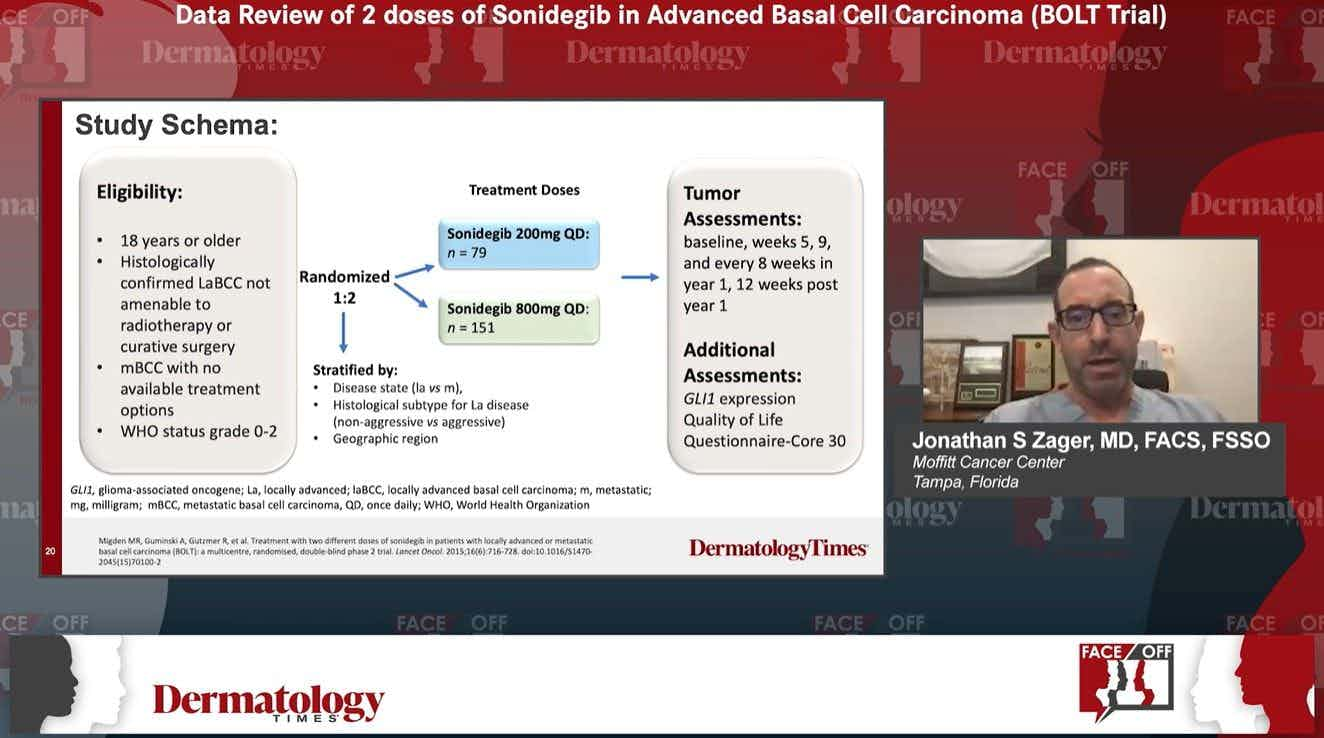- Acne
- Actinic Keratosis
- Aesthetics
- Alopecia
- Atopic Dermatitis
- Buy-and-Bill
- COVID-19
- Case-Based Roundtable
- Chronic Hand Eczema
- Chronic Spontaneous Urticaria
- Drug Watch
- Eczema
- General Dermatology
- Hidradenitis Suppurativa
- Melasma
- NP and PA
- Pediatric Dermatology
- Pigmentary Disorders
- Practice Management
- Precision Medicine and Biologics
- Prurigo Nodularis
- Psoriasis
- Psoriatic Arthritis
- Rare Disease
- Rosacea
- Skin Cancer
- Vitiligo
- Wound Care
News
Article
New Clinical Guidelines for Nonmelanoma Skin Cancer Published by Dermatology Association of Radiation Therapy
Author(s):
The guidelines for BCC and SCC treatment with IGSRT detail diagnosis, staging, contraindications, protocols, and emphasize the essential role of a multidisciplinary team.
The Dermatology Association of Radiation Therapy (DART) announced today the publication of new clinical guidelines for the treatment of nonmelanoma skin cancers, basal cell carcinoma (BCC) and squamous cell carcinoma (SCC).1 The guidelines were developed collaboratively by DART's education and research committees.
Focus on Image-Guided Superficial Radiation Therapy (IGSRT)
At the core of the new guidelines is the emphasis on the use of image-guided superficial radiation therapy (IGSRT). This technique combines high-resolution dermal ultrasound imaging with superficial radiation therapy, allowing for precise targeting of cancerous tissues. The guidelines offer comprehensive criteria for the use of IGSRT in treating both BCC and SCC, covering aspects such as:
- Diagnosis and staging
- Indications and contraindications
- Detailed treatment protocols
- Follow-up procedures
Multidisciplinary Approach
A significant component of the guidelines is the strong endorsement of a multidisciplinary team approach. The guidelines specify that IGSRT should be administered in dermatology settings by a board-certified dermatologist, supported by a multidisciplinary team that includes:
- A board-certified radiation therapist for treatment delivery
- Access to a board-certified radiation oncologist
- Access to a medical physicist
- Organized weekly national Grand Rounds for complex case discussions
BCC- Specific Guidelines
Within the guidelines,2 BCC risk factors are categorized into low and high risk. Low-risk factors include tumors less than 2.0 cm on the trunk or extremities, well-defined borders, primary occurrence, no immunosuppression, and non-aggressive histologic subtypes.
High-risk factors include tumors 2.0 cm or larger on the trunk or extremities, tumors on the head, neck, hands, feet, poorly defined borders, recurrent occurrence, immunosuppression, prior radiation at the same site, aggressive histologic subtypes, and perineural involvement.
Absolute contraindications for IGSRT include Gorlin’s syndrome, xeroderma pigmentosum, ataxia telangiectasia, prior ionizing radiation at the proposed treatment site, Ehlers-Danlos syndrome, scleroderma, mixed connective tissue disease, and systemic lupus erythematosus.
Relative contraindications depend on specific BCC subtypes. High-resolution diagnostic ultrasound imaging imaging is crucial for accurate diagnosis and staging, confirming or revealing tumor characteristics post-biopsy, according to the guidelines.
SCC- Specific Guidelines
In accordance with the guidelines,2 low-risk SCC tumors are generally located on the trunk or extremities, measuring 2.0 cm or less in diameter, and are well-defined with primary occurrence and no immunosuppression.
High-risk tumors are those larger than 2.0 cm, with poor definition, recurrent occurrence, or present in immunosuppressed patients. Tumors with any very high-risk factors, such as a depth greater than 6.0 mm or perineural involvement, are not suitable for IGSRT and require more aggressive treatments, including surgery, systemic therapy, or immunotherapy.
Contraindications for IGSRT include absolute contraindications that match those specified in the BCC guidelines. Similarly, high-resolution diagnostic ultrasound imaging is also outlined in these guidelines.
Both sets of guidelines also establish methodology for debulking, subtypes, and appropriate margins.
Future Directions
DART President and Chairman, Jacob Scott, MD, DPhil, DABR, emphasized the organization's dedication to ensuring that patients with nonmelanoma skin cancer have access to effective and safe radiation-based treatments.
“When delivered in accordance with these evidence-based guidelines, IGSRT is shown to be safe and up to 99 percent effective at eradicating these cancers,” Scott said in a news release.1 "We're absolutely committed to ensuring that all appropriate patients with nonmelanoma skin cancer have access to safe and effective, noninvasive, radiation-based treatments in the outpatient dermatology setting, and that those undergoing treatment receive quality care in accordance with the latest evidence-based research and best practice standards of care."
References
- Dermatology Association of Radiation Therapy publishes new clinical guidelines for the treatment of nonmelanoma skin cancer. News release. PR Newswire. July 22, 2024. Accessed July 22, 2024. https://www.prnewswire.com/news-releases/dermatology-association-of-radiation-therapy-publishes-new-clinical-guidelines-for-the-treatment-of-nonmelanoma-skin-cancer-302202264.html
- Dermatology Association of Radiation Therapy. DART clinical guidelines for nonmelanoma skin cancer. Accessed July 22, 2024. https://dermassociationrt.org/guidelines/
Newsletter
Like what you’re reading? Subscribe to Dermatology Times for weekly updates on therapies, innovations, and real-world practice tips.
















